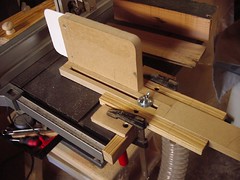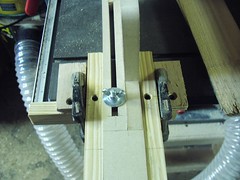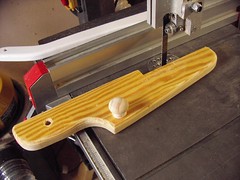OPJ
Established Member
We're all aware of featherboards, but I reckon there's a good chance many of you reading this haven't seen one of this, which uses a small piece of 1.5mm thick (perfect fit in a bandsawn kerf!) plastic laminate (sold dead cheaply as 'plasticcard' on eBay).

This is an idea taken from one of the Wood Magazine books for ideas on a range of woodworking machine; from table saws to pillar drills. The main difference with mine though is that it's designed to be clamped to the table - although I may refine this at some point - where as, in the original design, their idea is bolted to a large MDF sub-table with housing in the base.
You can (hopefully!) see how it works. It's an aid designed to keep the stock tight against the fence when resawing. And, because of the way this plastic bends, it prevents the timber from kicking back at you - not a problem for the bandsaw, I know; but I'll be looking to make some smaller ones for my router table very soon.

It is, however, very easy to put too much pressure on the stock, which can cause it to drift away quite dramatically towards the end of the cut. I may try adding a second guide behind the blade - but I'm concerned there about binding on the blade and not allowing the timber to curl away. Would it be better to position the guide to the side of the actual blade, rather than infront of it?
Obviously, the larger the depth of cut, the greater the height the rip fence needs to be when supporting the stock - especially on thin stuff. I haven't quite finished the large resaw fence I'm making, although I may use some more of this 'plasticcard' on the face.
You may also be interested in the design of this push stick, which I obtained from another book; Success with Bandsaws.

This allows you to keep smaller and shorter stock against the fence using only one pushstick. I added a small wooden knob to mine to help control it, while my left hand applies the forward pressure on the long 'handle'.
One last tip - for correct setting of standard featherboards, trim 3mm off the length of the first 'feather' and set the timber to that against the fence.
Thanks again for taking a look and I hope it may be of some use to some of you.

This is an idea taken from one of the Wood Magazine books for ideas on a range of woodworking machine; from table saws to pillar drills. The main difference with mine though is that it's designed to be clamped to the table - although I may refine this at some point - where as, in the original design, their idea is bolted to a large MDF sub-table with housing in the base.
You can (hopefully!) see how it works. It's an aid designed to keep the stock tight against the fence when resawing. And, because of the way this plastic bends, it prevents the timber from kicking back at you - not a problem for the bandsaw, I know; but I'll be looking to make some smaller ones for my router table very soon.

It is, however, very easy to put too much pressure on the stock, which can cause it to drift away quite dramatically towards the end of the cut. I may try adding a second guide behind the blade - but I'm concerned there about binding on the blade and not allowing the timber to curl away. Would it be better to position the guide to the side of the actual blade, rather than infront of it?
Obviously, the larger the depth of cut, the greater the height the rip fence needs to be when supporting the stock - especially on thin stuff. I haven't quite finished the large resaw fence I'm making, although I may use some more of this 'plasticcard' on the face.
You may also be interested in the design of this push stick, which I obtained from another book; Success with Bandsaws.

This allows you to keep smaller and shorter stock against the fence using only one pushstick. I added a small wooden knob to mine to help control it, while my left hand applies the forward pressure on the long 'handle'.
One last tip - for correct setting of standard featherboards, trim 3mm off the length of the first 'feather' and set the timber to that against the fence.
Thanks again for taking a look and I hope it may be of some use to some of you.


